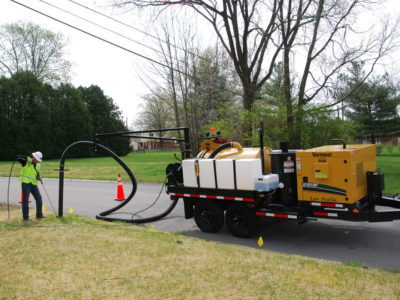Vacuum excavators have earned the reputation of being a safe alternative to traditional methods of exposing buried utilities in the underground construction industry. While this soft excavation method will help reduce the risk of a utility strike, there are a few safety guidelines that workers need to follow to keep themselves and the people around them safe when working with vacuum excavators.
Training and education
The most important step that any equipment operator can follow is educating and training themselves on the proper way to operate a machine. For vacuum excavators, manufacturers like Vermeer and its network of dealers offer a wide range of training options for contractors. It is also important for anyone operating a vacuum excavator to review the operator’s manual ahead of time and walk around the machine to review any safety decals.
“Taking the time to ensure the operator understands how everything works is vital for safe operations,” explained Jake Jeffords, director of sales and marketing for Vermeer MV Solutions. “Our dealers are a great resource for anyone new to vacuum excavators and are more than happy to help operators get up to speed quickly.”
In addition to making sure every operator is properly trained, Jeffords said several other safety guidelines should be reviewed and followed on every job. These steps can be divided into jobsite, travel and maintenance safety categories.
Jobsite safety
Since vacuum excavators can be used in a range of applications and environments, it is important to understand and follow all applicable OSHA and/or any state or local regulations.
- Wear the proper personal protective equipment (PPE): With vacuum excavators, PPE requirements can vary based on the type of system being used (air or hydro) and the working environment. Operators need to make sure they are wearing the appropriate boots (working near live electrical lines requires dialectic boots), eye protection, gloves, a hard hat, ear plugs and reflective clothing. In addition, loose clothing should never be worn near a suction hose, and long hair should always be pulled back.
- Know the surroundings:Vac operators need to make sure they inspect the jobsite to ensure all utilities have been located and any above-ground or in-the-air obstacles have been accounted for. When working near roadways or busy sidewalks, safety cones and appropriate signage should always be used. Also, all open holes need to be fenced off or covered when work isn’t currently being done.
- Maintain a safe distance during operations:It is important to maintain a safe distance whenever the vacuum excavator’s tank door is open — no one should be standing near the rear of the machine. Also, operators need to make sure they don’t get too close to open holes since cave ins are possible in this line of work. Operators also need to keep their limbs away from the front of the water or air wand and the vacuum hose nozzle.
- Avoid using more pressure than needed:Whether using a hydro or air vacuum, applying too much pressure can damage utility lines.
Safe travel
Just as important as maintaining a safe jobsite, safety needs to be the top priority when traveling between jobs or back and forth to dump sites.
- Know the law:Whether operating a trailer-mounted, truck-mounted or PTO truck vacuum excavator, operators need to make sure they understand all state and local Department of Transportation (DOT) load restrictions and have the appropriate permits and licenses.
- Keep it clean and organized:Jobsites can be muddy and sometimes not everything gets put back where it’s supposed to go on the truck or trailer. Operators should do a quick walk around to ensure everything is secured and clean. Loose rocks or tools can become dangerous projectiles at travel speeds.
- Double check trailer hookups:Before leaving a job, make sure the trailer lights are working and the trailer is secured to the truck. Trailer safety chains need to be crossed under the hitch and attached to the truck.
- Check for obstacles when backing up:When it is time to dump, drivers should make sure a safe distance is maintained from the pit and electrical lines that could come in contact with the tank when its raised to dump.
Routine maintenance
Performing routine maintenance and daily walkarounds of equipment can go a long way in identifying and correcting any issues before they become a safety hazard.
- Ensure tires are in good condition and aired up.
- Check lights
- Check hoses and fittings
- Look for leaks
- Inspect belts
Proper training and making sure everyone working around vacuum excavators follow these tips will help keep everyone safe on the job. For additional information and resources, contact your local Vermeer dealer.
